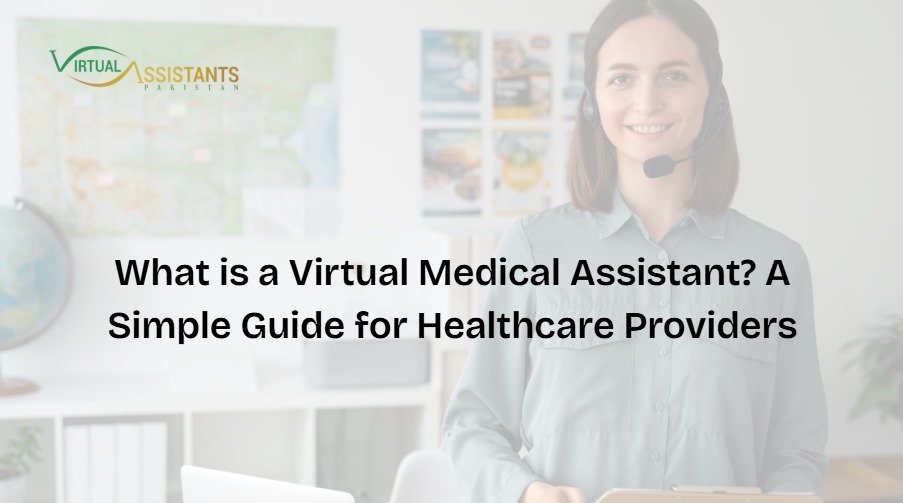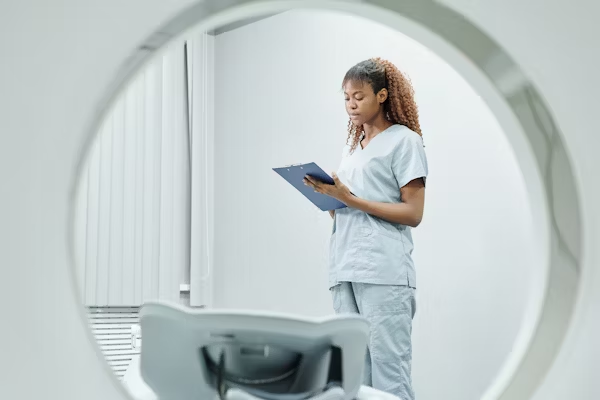Health & Fitness
What is a Virtual Medical Assistant? A Complete Guide for Healthcare Providers

Healthcare in the U.S. is more demanding these days than before. Doctors, clinics, and telehealth providers are doing a big job: giving good care and managing lots of paperwork. Tasks like booking appointments, updating records, and billing can be very tiring.
That is the point, you need Virtual Medical Assistants (VMAs). Just like virtual assistants in business, VMAs work remotely to handle important but time-consuming tasks—freeing up doctors and staff to focus more on patients. More and more medical practices across the U.S. are hiring trained virtual assistants from overseas to help with both administrative and clinical work. Why? Because it saves money, boosts efficiency, and gives access to skilled professionals who can manage things like EMR updates, patient follow-ups, and more. If you have been asking, “What is a virtual medical assistant, and how could one help my practice?” — this guide has the answers.
Definition & Core Role
What is a Virtual Medical Assistant?
A Virtual Medical Assistant (VMA) is a trained professional who works remotely and facilitates healthcare providers with admin tasks, simple clinical duties, and daily operations. Instead of working on-site, VMAs typically work from countries such as the Philippines or Pakistan, but use online tools to stay connected and work as part of the team.
Their core role is simple: reduce the non-medical workload of healthcare providers so that doctors and staff can focus more on patient care. From managing schedules to updating medical charts, VMAs are the “behind-the-scenes” team members keeping clinics running smoothly.
Difference Between a Medical VA and a General VA
It is very important to understand how a Medical Virtual Assistant differs from a General Virtual Assistant:
Medical Virtual Assistant:
- Specialization in healthcare.
- They know medical terms, follow HIPAA rules, use EMR/EHR systems, and understand insurance.
- Handles sensitive patient information responsibly.
General Virtual Assistant:
- Provides administrative support for businesses in various industries.
- May lack medical-specific training.
- Not suitable for handling confidential patient records.
For US healthcare providers, this difference matters a lot. A regular Virtual Assistant does only simple tasks like book appointments or answer calls, but a Medical VA is trained and has special knowledge to use EMR systems, work with pharmacies, and handle insurance claims.
Responsibilities of a Medical Virtual Assistant
Medical Virtual Assistants (VMAs) facilitate doctors by completing their different tasks, like admin and basic clinical tasks, making their workday smoother and more efficient. Here’s what they usually do:
Administrative Tasks (Scheduling, Patient Intake, Data Entry)
- Appointment Scheduling
First of all, they manage the doctor’s calendar, book appointments, confirm visits, and handle rescheduling.
- Patient Intake
They collect patient info before the visit, like contact details, medical history, and insurance info.
- Data Entry
They also manage and update their electronic medical records (EMR/EHR) with the help of accurate patient data.
By taking care of the responsibility of these tasks, VMAs help doctors to avoid constant phone calls and reduce paperwork, freeing up the clinic staff to focus more on patient care.
Clinical Support (EMR Updates, Prescription Coordination)
Virtual Medical Assistants (VMAs) can help out doctors with only those tasks that don’t involve direct patient care. For example, they can:
- Add doctor’s notes, test results, and patient history into the system
- In touch through Call or message with pharmacies to refill prescriptions
- They call patients to remind them about lab tests, scans, or follow-up visits.
- They also help keep everything organized to make sure the clinic runs well.
Billing and Insurance Help
Handling medical bills and insurance can take a lot of time. A trained VMA can:
- Send and track insurance claims
- Check if a patient’s insurance is active
- Help fix any issues if claims are denied
- Create bills for patients
This helps doctors get paid on time and reduces billing mistakes.
Patient Communication and Follow-Ups
VMAs also help keep in touch with patients by:
Replying to patients through phone, email, or text
Reminding patients about their next visit
Taking reviews of patients to see how they’re doing after an appointment
Sharing simple care instructions from the doctor
This makes patients feel cared about and helps them to stay on track with their treatment.
Benefits of Hiring a Virtual Medical Assistant
Let’s look at the key benefits of hiring a VMA in the US healthcare space.
- Cost Savings vs. In-House Staff
Hiring a local, in-house medical assistant in the US can be much more expensive, including salaries plus benefits, office space, and training.
When we make a comparison, hiring a virtual medical assistant from countries like Pakistan or the Philippines can reduce costs by up to 60–70%, without hurting or compromising quality. This makes outsourcing highly attractive for small clinics and solo practitioners.
- Increased Productivity for Doctors
Doctors often spend 1–2 hours daily on admin tasks instead of patient care. With a VMA:
- Physicians regain valuable time.
- Clinics can achieve more appointments per day.
- Reduced workload and stress for the doctor
- Simply hand over tasks to boost efficiency and work-life balance.
- 24/7 Availability & Time Zone Advantages
Many VMAs work across different time zones, allowing for round-the-clock support. For example:
- A US-based clinic can hire a VMA from Pakistan, where the time zone difference allows tasks like billing, chart updates, and scheduling to be completed overnight.
- This creates a 24/7 operational cycle, keeping the clinic always “on”.
- HIPAA Compliance & Data Security
One of the top concerns in healthcare outsourcing is patient data safety. Reputable VMA providers ensure:
- Training in HIPAA compliance.
- The use of secure platforms, like encrypted EMR/EHR access and password-protected systems.
- Strict agreements.
- This means US healthcare providers can safely outsource without compromising patient privacy.
Tools & Technology Used by Medical VAs
Let’s look at the tools Virtual Medical Assistants (VMAs) use to work easily and accurately with US clinics. These tools help them finish tasks quickly and safely, even from home.

Common Specializations of Medical Virtual Assistants
Not all VMAs perform the same functions. Many specialise in specific healthcare areas, depending on the clinic’s needs.
- Medical Billing Virtual Assistant
Handles insurance claims, billing, collections, and payment tracking. This is especially helpful for clinics with denied claims or late payments.
- Telemedicine Virtual Assistant
With the growth of telehealth, VMAs now assist with:
- Scheduling virtual consultations.
- Setting up telemedicine platforms.
- Troubleshooting tech issues for patients.
- Recording and updating post-consultation notes.
- Dental Virtual Assistant
Dental practices benefit from VMAs who can:
- Manage patient recalls.
- Handle insurance verification.
- Support dental charting and imaging coordination.
- Chiropractic & Allied Health VA
Many healthcare specialists, like chiropractors, physical therapists, and nutritionists, use VMAs to:
- Manage appointments.
- Track patient progress.
- Provide administrative support for wellness programmes.
These niche specialisations allow providers to hire VMAs tailored to their exact field.
Why Hire a Virtual Medical Assistant from Pakistan?
Many US clinics turn to Pakistan when outsourcing Virtual Medical Assistants. Here’s why:
- Cost-Effective Talent Pool
VMAs from Pakistan typically cost 60–70% less than hiring in-house US staff. This makes them a better and the best choice for small to mid-sized clinics working on tighter budgets.
- Skilled English-Speaking Workforce
Pakistan has many skilled and educated workers who have special training to speak English well. They are trained and enabled to understand the US healthcare system, which also helps them to communicate clearly with both patients and clinic staff.
- Time Zone Advantage for US Clinics
The time difference between Pakistan and the US allows clinics to:
- Assign tasks at the end of the workday.
- Receive completed work by the next morning.
- Run your operations 24/7 without extra pay.
Comparison: Pakistan vs. Philippines
While the Philippines is also a popular outsourcing hub, Pakistan is emerging as a strong competitor due to:
- Lower costs compared to the Philippines.
- Highly skilled workforce with medical and IT backgrounds.
- The rapidly growing outsourcing industry is focused on healthcare.
For US providers, Pakistan offers a balance of affordability, expertise, and reliability.
How to Hire a Virtual Medical Assistant
Hiring the right Virtual Medical Assistant (VMA) is very important for long-term success. Here’s a step-by-step guide for US healthcare providers:
- Choosing the Right VA Provider
Starting with a reputable and reliable outsourcing company or freelance marketplace that specializes in healthcare-trained VAs. Look for:
- Agencies with proven experience in US healthcare.
- Providers who train VAs in HIPAA compliance.
- Positive client testimonials and case studies.
- Interview & Training Tips
Treating the hiring process for a virtual assistant (VA) is similar to hiring in-house staff.
- Interview of several candidates to test their communication skills.
- Use case-based questions to check their IQ level and decision-making.
- Provide them basic training on your tools, processes, and daily tasks.
- Cost Breakdown of Hiring a Medical VA
On average:
- In-house US medical assistant: $18–$22/hour + benefits
- Medical VA (Philippines/Pakistan): $6–$12/hour
- You save up to 60–70% without compromising on quality.
- Key Questions to Ask Candidates
Have you used EMR/EHR systems before?
Are you trained in HIPAA compliance?
What type of healthcare work have you done?
How do you keep patient data secure when working remotely?
Can you share references or client feedback?
These questions help you find skilled and trustworthy VAs.
Conclusion
A Virtual Medical Assistant (VMA) is more than just an admin helper. You can say they are an extension of your healthcare team. They handle different tasks, such as scheduling and billing, to patient communication and telemedicine support. VMAs bring efficiency, cost savings, and flexibility to US clinics.
Doctors can hire trained Virtual Medical Assistant (VMA) from countries like Pakistan, where people speak good English and cost less. This way, they can spend less time on paperwork and more time with patients.
So if you’re asking, “Should I get a Virtual Medical Assistant?” — the simple answer is yes. It helps you save money, get more done, and take better care of your patients.
FAQs
Q1. What is a Virtual Medical Assistant?
A Virtual Medical Assistant (VMA) is a trained worker who helps doctors from home through basic office tasks, simple medical tasks, and daily clinic routines.
Q2. Are Virtual Medical Assistants HIPAA compliant?
A qualified Virtual Medical Assistant follows HIPAA rules and also uses secure systems to keep patients’ data safe.
Q3. How much does it cost to hire a Medical VA?
It depends on the type of work or experience.
Q4. Why should I hire a Medical VA from Pakistan?
Because you get skilled, English-speaking professionals at a fraction of the cost, with the added benefit of time zone advantages for faster turnaround.
Health & Fitness
What You’re Not Told About Imaging Appointments

Imaging appointments are routine in modern healthcare, yet what actually happens during and around them is often poorly explained.
Patients and even some clinicians frequently walk into these appointments with a limited understanding of what the procedures entail, what to expect, and what the results can and cannot reveal.
This gap in communication can lead to avoidable stress, delays, and misinformed decisions.
Preparation Is Not Always Straightforward
One thing patients are rarely told is that preparation for imaging isn’t always as simple as following generic instructions. Whether you’re attending for an MRI, CT, PET scan, or ultrasound, the preparatory steps can vary significantly.
Fasting might be advised, but in some cases, medication may need to be stopped, or special instructions followed to ensure safety and accuracy. For instance, patients with kidney problems may require specific blood tests before receiving contrast agents, yet this is not always communicated clearly ahead of time.
Contrast Agents Come with Considerations
Another overlooked aspect is the use of contrast media. These are substances injected or swallowed to help visualise certain areas of the body more clearly. Although widely used and generally safe, contrast agents are not risk-free.
Individuals with asthma, allergies, or impaired kidney function may be more prone to adverse effects. However, the risks, alternatives, or implications are often not discussed in meaningful detail, and consent tends to be limited to a signature rather than an informed discussion.
Your Radiologist May Not Be Who You Expect
Patients also rarely hear about what happens to their scan once it’s complete. Many assume their doctor will interpret the results, when in fact, it’s a radiologist, often someone they will never meet, who analyses the images and writes a report.
Even more surprising is that not all radiologists interpret all types of scans. A specialist in musculoskeletal imaging, for example, is not best placed to assess a brain scan. This matters, especially in complex or borderline cases, yet patients are not informed who is reading their images, or whether a second opinion is warranted.
Delays Are Common—and Often Unexplained
Another layer often left unexplained is the turnaround time for results. While some scans are prioritised, others may take days or even weeks depending on urgency, availability of specialists, or local healthcare pressures.
This delay is not always factored into clinical planning, which can result in unnecessary anxiety or postponement of treatment. Worse still, patients are rarely told that they can and sometimes should chase results if delays exceed what’s clinically reasonable.
Radiology Reports Are Hard to Understand
The way results are delivered can also be problematic. Radiology reports are written in technical language, often full of abbreviations and hedged statements that make interpretation difficult. Even when patients gain access to their reports, the findings may be unclear without a doctor’s explanation. And even then, the conclusions are not always definitive.
A scan might reveal something, but it doesn’t always explain it. Many findings are incidental or ambiguous, requiring further testing or simply ongoing observation, and resources such as InsideRadiology Australia help standardise the terminology clinicians use to communicate these results more clearly.
Imaging Is Only Part of the Picture
What’s rarely emphasised is that imaging is just one part of the diagnostic process. A normal scan doesn’t always rule out disease, and an abnormal one doesn’t automatically confirm it.
Imaging must be interpreted in the wider context of symptoms, history, and other investigations. Yet patients are often led to believe the scan alone holds all the answers, which can distort expectations and complicate shared decision-making.
A Hidden Knowledge Gap
In truth, what patients aren’t told about imaging appointments is not usually due to negligence, but time constraints and systemic gaps in communication.
Still, the impact is the same: people attend appointments without fully knowing what will happen, why it matters, or what the results will mean. For something as central to healthcare as medical imaging, that’s a silence we can no longer afford.
Health & Fitness
Boost Your Career as a Personal Trainer with ASFA’s Certification

The fitness industry has never been more dynamic or full of opportunity than it is today. With people around the world prioritizing health, wellness, and fitness, the demand for qualified personal trainers continues to soar. Whether you’re just starting out or looking to advance your career, earning a credible certification can make all the difference.
That’s where https://www.americansportandfitness.com/products/personal-trainer-certification comes in. Designed to help aspiring and experienced trainers alike, this certification program provides the foundation, knowledge, and professional credibility needed to thrive in today’s competitive fitness landscape.
Let’s explore how this certification can help you boost your career, expand your opportunities, and position yourself as a trusted fitness professional.
1. Why Certification Is Essential for Personal Trainers
Being passionate about fitness is important — but passion alone isn’t enough to build a successful career as a trainer. Clients today expect their trainers to have a deep understanding of exercise science, nutrition, safety, and personalized programming.
A professional certification demonstrates that you have the knowledge, skills, and commitment required to help clients reach their goals safely and effectively. It also signals to gyms, studios, and clients that you’re a qualified expert who follows industry best practices.
With ASFA’s Personal Trainer Certification, you gain not only expertise but also credibility — a key ingredient for success in the fitness industry.
2. What Makes ASFA’s Certification Stand Out
The American Sports and Fitness Association (ASFA) offers one of the most flexible and recognized certification programs for fitness professionals. Unlike traditional classroom-based courses that require fixed schedules and expensive materials, ASFA’s program is 100% online and self-paced, allowing you to study on your own time and at your own speed.
Here’s what makes this certification unique:
- Fully Online Learning and Testing: You can complete the entire certification process from anywhere, anytime.
- Self-Paced Progression: Move through the material at your own pace — perfect for working professionals or students.
- Instant Certification: Once you pass the exam, you receive your certificate immediately.
- Affordable and Accessible: ASFA keeps pricing reasonable, making high-quality education accessible to all.
- No Renewal Hassles: Unlike many programs, ASFA certifications do not expire, saving you both time and money.
- Respected Industry Reputation: ASFA certifications are trusted by fitness centers, employers, and clients worldwide.
This flexible structure allows you to balance your certification journey with your personal and professional commitments, setting you up for long-term success.
3. What You’ll Learn in ASFA’s Personal Trainer Certification
ASFA’s certification program covers the essential knowledge areas required to become an effective and professional personal trainer.
Here’s a breakdown of what you’ll gain:
a) Anatomy and Exercise Science
You’ll learn how the human body moves, how muscles function, and how different exercises impact performance, strength, and endurance.
b) Fitness Assessments
Learn how to assess a client’s physical condition, identify areas for improvement, and set realistic goals tailored to their needs.
c) Program Design
Master the art of creating personalized workout plans that align with client goals — whether they’re focused on fat loss, strength, endurance, or general fitness.
d) Nutrition Fundamentals
Understand the basics of nutrition and how to complement workout programs with healthy lifestyle guidance.
e) Client Motivation and Communication
Develop strong communication and leadership skills to keep clients motivated, engaged, and committed to their fitness journey.
f) Injury Prevention and Safety
Learn how to ensure proper form, avoid overtraining, and design safe programs that reduce the risk of injury.
By the end of your certification, you’ll have the confidence and expertise to help clients reach their goals safely and effectively — whether in a gym, at home, or online.
4. How ASFA Certification Boosts Your Career
a) Stand Out in a Competitive Industry
The fitness market is saturated with self-taught trainers, but clients and employers prefer certified professionals. With your ASFA certification, you’ll stand out as a knowledgeable and credible expert — giving you a clear advantage over competitors.
b) Unlock New Opportunities
Once certified, you can work in a variety of settings, including gyms, fitness studios, wellness centers, sports clubs, and even corporate wellness programs. You can also launch your own private training or online coaching business.
c) Increase Your Earning Potential
Certified trainers often earn higher rates than non-certified instructors. Your certification demonstrates professionalism and expertise — qualities that justify premium pricing for your services.
d) Build Long-Term Client Relationships
ASFA’s training doesn’t just focus on exercise techniques — it teaches you how to connect with clients, understand their goals, and guide them through sustainable transformations. This results in higher satisfaction and retention rates.
e) Continuous Professional Growth
The certification is also a stepping stone for more advanced credentials. After becoming a certified personal trainer, you can pursue specializations such as group fitness, sports conditioning, or senior fitness training.
5. Who Should Get ASFA’s Personal Trainer Certification?
The ASFA Personal Trainer Certification is suitable for anyone looking to build or advance a career in the fitness industry, including:
- Aspiring Trainers who want to start a new career in fitness.
- Current Fitness Instructors who want to formalize their training credentials.
- Sports Coaches and Athletes seeking to expand their knowledge in exercise science.
- Health and Wellness Enthusiasts passionate about helping others achieve fitness success.
No prior experience or degree is required — just a love for fitness and a desire to help others live healthier lives.
6. The Flexibility of ASFA’s Online Learning
Traditional certification programs often require travel, attendance, and strict class schedules. ASFA removes all those barriers. With its online learning format, you have complete control over your study environment and pace.
You can prepare for the certification exam from anywhere — at home, in the gym, or even while traveling. This flexibility is perfect for those who are balancing multiple commitments but still want to invest in professional growth.
7. Steps to Get Certified
Getting certified with ASFA is quick, easy, and straightforward:
- Visit the official website: ASFA’s Personal Trainer Certification
- Review the certification details and register for the program.
- Study the material at your convenience and prepare for the online exam.
- Take the exam when you’re ready — no deadlines or scheduling required.
- Receive your certificate instantly upon passing.
Once certified, you can immediately begin applying for jobs or offering personal training services.
8. Real Success Stories from ASFA Graduates
Thousands of fitness professionals have used ASFA certifications to elevate their careers. Many have transitioned from enthusiasts to full-time personal trainers, while others have opened their own gyms or online coaching businesses.
ASFA’s certification doesn’t just provide knowledge — it provides opportunity. It empowers you to take your fitness passion and turn it into a meaningful and financially rewarding profession.
9. Why Choose ASFA Over Other Programs
While there are many certification providers, ASFA’s reputation for quality, accessibility, and affordability makes it a preferred choice among fitness professionals.
Here’s why:
- Comprehensive Curriculum: Balanced coverage of theory and practical skills.
- Global Recognition: ASFA-certified trainers are respected worldwide.
- No Hidden Fees or Renewals: Your certification stays valid for life.
- Affordable Entry Point: High-quality education without expensive costs.
- Instant Results: Certification available immediately after passing the exam.
ASFA truly makes professional development simple and effective — helping you reach your goals faster.
10. Final Thoughts
Building a successful career as a personal trainer requires more than motivation — it requires credibility, skill, and the right certification. The ASFA’s Personal Trainer Certification provides all three.
Whether you want to start your fitness career, grow your client base, or transition into full-time coaching, ASFA offers the perfect platform to get started. Its online format, affordable pricing, and respected reputation make it one of the most practical certifications for trainers worldwide.
Take charge of your career today. Enroll in ASFA’s certification program and open the door to exciting new opportunities in the world of fitness.
Health & Fitness
Elevating Hormone Wellness in Pennsylvania: A Positive Review of Bioidentical Hormone Replacement Therapy

When seeking hormone balance and vitality in Pennsylvania, it’s vital to find a clinic that understands your needs, uses safe and modern techniques, and places your health first. That’s why many people turn to Sanctuary Wellness Institute, because of Why We Only Use Bioidentical hormone therapies and their patient-centric philosophy. In this article, we’ll explore how their approach works, why their focus on Why We Only Use Bioidentical hormones matters, and why this institute stands out in the field of hormone replacement therapy (HRT).
Understanding Bioidentical Hormone Replacement Therapy (BHRT)
Bioidentical hormone replacement therapy (BHRT) refers to treatments that use hormones whose chemical structure is identical to those naturally produced by the human body. For many people in Pennsylvania, dealing with hormonal shifts due to aging, menopause, andropause, or other health changes, BHRT offers an attractive option. It’s precisely because the molecules match the body’s own hormones that Why We Only Use Bioidentical becomes the core of Sanctuary Wellness Institute’s messaging.
The appeal is clear: these hormones are designed to integrate seamlessly into the body’s signaling systems, reducing the risk of “foreign” compounds, and aligning with the concept of restoring natural balance. While conventional HRT uses synthetic or non-identical hormones, BHRT aims for a more “natural” feel. The team at Sanctuary Wellness Institute emphasizes this point in every consultation: we are restoring your hormone balance, not introducing something entirely artificial.
Beyond the structural similarity, they tailor doses, delivery methods, and monitoring protocols so that hormone levels reflect your unique physiology. This active, individualized approach makes BHRT — and specifically their version of BHRT — stand out from one-size-fits-all treatments.
Why We Only Use Bioidentical: The Guiding Principle at Sanctuary Wellness Institute
At the heart of the Sanctuary Wellness Institute’s philosophy lies the phrase Why We Only Use Bioidentical. Let’s unpack what that means and why it matters in real life.
First, the decision to use only bioidentical hormones reflects a commitment to compatibility and precision. Because these hormones mirror what your body already produces, the hope is fewer unwanted reactions and better outcomes. Sanctuary Wellness Institute stresses that this is not just marketing — it’s a clinical decision based on how the body responds.
Second, the phrase underscores their dedication to clarity and education. Patients aren’t left wondering, “Why this hormone? Why that dose?” Instead, the team explains: “Because you are receiving bioidentical hormones, we have optimized your dose to reflect your lab work, symptoms, and goals.” By repeating Why We Only Use Bioidentical, they remind patients of the uniqueness of their care and the importance of selecting the right hormone type.
Third, the institute ties this decision to overall wellness rather than merely symptom control. At Sanctuary Wellness Institute, the idea is that hormone balance influences energy, mood, cognitive clarity, body composition, and overall vitality. When patients ask, “Why choose bioidentical?,” the answer given is straightforward: we want to help you feel like yourself again — naturally, gradually, and with fewer side-effects.
What the Treatment Process Looks Like
When you choose Sanctuary Wellness Institute, you embark on a thorough, personalized journey. It typically begins with a detailed consultation: medical history, symptom review, prior hormone use, lifestyle and nutrition. Because they adhere to Why We Only Use Bioidentical, the evaluation is more in depth — not just “Are your hormone levels low?” but “How do they compare to benchmarks for your age and wellness goals?”
Next comes targeted lab work. Many clinics rely on generic panels, but this institute takes the extra step to measure a broad range of hormones and metabolic indicators, ensuring the approach is tailored. Then the team designs a hormone plan that uses bioidentical formulas — delivered via the route that fits you best (e.g., capsules, patches, creams, or pellet therapy) — always aligned with Why We Only Use Bioidentical principles.
Once the program starts, they monitor your response carefully — symptoms, lab results, side-effects, and overall health. The team communicates with you, adjusts doses as needed, and integrates lifestyle support (nutrition, sleep, stress management). Because the foundation is bioidentical hormones, the adjustments feel more “fine-tuning” than major overhauls. Over time, many patients report better energy, improved mood, clearer cognition, improved body composition, and renewed sense of well-being.
The Benefits You Can Expect (and Why They Matter)
When your body’s hormone systems are out of balance, the effects can ripple across every major system — heart health, bone health, mood regulation, sleep, metabolism, and more. At Sanctuary Wellness Institute, where Why We Only Use Bioidentical is emphasized, patients often report one or more of the following benefits:
- Increased energy and reduced fatigue, suggesting improved adrenal or thyroid-hormone support alongside the primary BHRT program.
- Improved mood and mental clarity — less “brain fog,” fewer mood swings, and better stress resilience.
- More stable sleep patterns and fewer night sweats or hot flashes (especially for women in perimenopause or menopause).
- Improved sexual drive, performance, and satisfaction — for both men and women, when testosterone, estrogen, or progesterone balance is restored.
- Enhanced body composition: more lean muscle, less fat accumulation, better metabolic efficiency (though lifestyle still matters).
- Bone and cardiovascular support: While BHRT isn’t a silver bullet, restoring hormone balance can contribute positively to bone density and cardiovascular markers — part of the broad wellness mission at Sanctuary Wellness Institute.
These benefits reflect the institute’s holistic vision: hormone therapy isn’t just about alleviating symptoms, but about optimizing your system so you can live with vitality, not just survive. The emphasis on Why We Only Use Bioidentical reinforces that objective.
Addressing Safety and Common Concerns
It’s natural to ask: is BHRT safe? What’s the catch? Sanctuary Wellness Institute acknowledges these questions openly. Because they are committed to Why We Only Use Bioidentical, they pair the hormone treatment with rigorous monitoring and transparency.
They explain that even though bioidentical hormones are structurally identical to human hormones, they still must be used carefully. Regular lab work, follow-ups, and lifestyle supports are essential. Patients with certain conditions (for example, active breast cancer, uncontrolled clotting disorders) may be directed to other therapies. The institute ensures you are informed and empowered about risks, benefits, and alternatives.
They also emphasize that hormone therapy is not an isolated fix — it works best when combined with good nutrition, movement, stress management, and appropriate sleep. This integrated message sets them apart: they don’t say “inject a hormone and you’re done”; they say “let’s restore your hormone health as part of your whole-body wellness.” Because they focus on Why We Only Use Bioidentical, they avoid generic dosing and instead use a custom plan tailored to your unique biology.
Why Choose Sanctuary Wellness Institute in Pennsylvania?
When there are multiple hormone therapy options in Pennsylvania, why pick Sanctuary Wellness Institute? Here are the aspects that make them a strong choice:
- A clear philosophy: They articulate Why We Only Use Bioidentical, and they back it up with personalized plans rather than cookie-cutter treatments.
- Personalized evaluation: From initial assessment to lab work to delivery method, every step is customized to you.
- Continuous support: Monitoring, feedback, dose-adjustments, lifestyle coaching — so you are not left alone after the first visit.
- A wellness-first mindset: They view hormone balance as part of total health and vitality, not just symptom suppression.
- Transparent communication: You get clear answers about why bioidentical hormones, what to expect, how long it may take, and how it integrates with your life.
Together, these factors reflect their bias (in a positive way) toward giving you the best possible outcome — a bias grounded in their belief in bioidentical hormones and individualized care. So if you’re considering hormone therapy in Pennsylvania and are comparing providers, Sanctuary Wellness Institute stands out as a committed, patient-focused choice where Why We Only Use Bioidentical isn’t just a slogan but the foundation of care.
A Few Practical Tips Before You Begin
- Schedule a full consultation— Make sure your provider is willing to spend time reviewing your complete medical history, symptoms, goals, and labs.
- Ask about delivery methods— Different people respond differently to patches, creams, injections, or pellets. At Sanctuary Wellness Institute, you’ll evaluate the best fit for your lifestyle and biology.
- Lifestyle integration matters— Hormone therapy is more effective when paired with good sleep, a balanced diet, regular movement, stress management, and avoidance of toxins.
- Set realistic timelines— While some patients notice improvement within weeks, optimization may take several months of tuning, monitoring, and lifestyle support.
- Stay informed— Ask why bioidentical hormones for you. Ask about monitoring, possible side-effects, when adjustments might be needed. Remember the statement: Why We Only Use Bioidentical — your provider should articulate that clearly.
- Budget and insurance— While some bioidentical products may be covered, others may not. Ensure you understand costs, refunds, and follow-up policies.
This kind of attention to detail, customization, and the clear philosophical stance of Why We Only Use Bioidentical makes the experience at Sanctuary Wellness Institute more than a routine clinic—it’s a wellness partnership.
In the fast-moving world of hormone science and wellness, it’s reassuring to find an institute that grounds itself in clarity, patient-focus, and modern hormone science. If you’re in Pennsylvania and looking to take control of your hormonal health, energy, and vitality, the path offered by Sanctuary Wellness Institute—with its commitment to personalized bioidentical hormone treatment—offers a thoughtful, highly-positive option. The difference lies in the phrase “Why We Only Use Bioidentical” and the real-life care you receive along with it.
Frequently Asked Questions
Q: What exactly are bioidentical hormones?
A: Bioidentical hormones are chemically identical to the hormones naturally produced by your body. Because of this molecular match, the philosophy behind their use is that your body may handle them more naturally, which is central to why Sanctuary Wellness Institute says Why We Only Use Bioidentical.
Q: How long does it take before I notice improvements after starting BHRT?
A: Many patients begin noticing improvements in a few weeks in terms of sleep quality, mood, or energy. Full optimization—when you feel consistently better—may take a few months of monitoring and adjustments. At Sanctuary Wellness Institute, the focus on Why We Only Use Bioidentical means they aim for the most natural timeline rather than rushing the process.
Q: Are there risks associated with bioidentical hormone therapy?
A: Yes. Although bioidentical hormones are structurally identical, hormone therapy still carries risks: changes in clotting, breast health, cardiovascular health, and others depending on your personal background. That’s why the monitoring and individualized care at Sanctuary Wellness Institute are important.
Q: Will insurance cover my treatment at Sanctuary Wellness Institute?
A: Coverage depends on the insurance plan, the specific hormone formulations used, and how the treatment is coded and documented. The team at Sanctuary Wellness Institute is experienced at working with patients on this and will help you understand costs and coverage in alignment with the “Why We Only Use Bioidentical” approach.
Q: What happens if I change my mind or my health changes and I need to stop therapy?
A: The system at Sanctuary Wellness Institute is designed to adapt — doses can be adjusted, delivery methods changed, or therapy tapered off if needed. Because they adhere strictly to the guiding principle of Why We Only Use Bioidentical, the emphasis is on your ongoing wellness, not making you locked into a one-size program.

 Blog10 months ago
Blog10 months agoHow to Deal with Scabies While Traveling

 Travel10 months ago
Travel10 months agoRichmond, Virginia Street Art Guide

 Travel10 months ago
Travel10 months agoPerhentian Islands: How to Get There, What to Expect, & More

 Travel10 months ago
Travel10 months agoHow to Live in Your Car in New Zealand

 Travel10 months ago
Travel10 months agoSouvenir in Nepal: A Guide to Unique Handicrafts and Cultural Treasures

 Travel10 months ago
Travel10 months agoVegan Guide to Dining Out in Richmond, Virginia

 Food10 months ago
Food10 months agoVegetarian Food Nepal: A Journey into Flavorful Plant-Based Cuisine

 Travel7 months ago
Travel7 months agoA Local’s Guide to Sanibel Island, Florida















